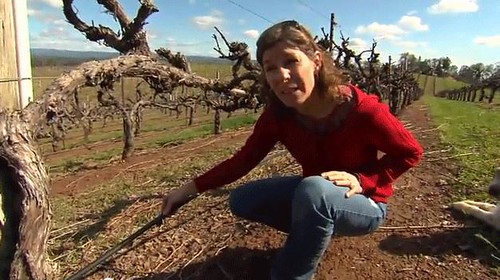Ann Johnson grows wine grapes in El Dorado County, Calif., where she carefully uses each drop of water. Water is imperative to her operation, and using it wisely and keeping it clean are important to private landowners like her.
Conservation practices, like a drip irrigation system, help her care for this natural resource. A public television series, “This American Land,” will showcase Johnson and other California farmers and ranchers who are working with USDA’s Natural Resources Conservation Service to put conservation on the ground.
The segment, “Precious Sierra Water,” is included in the season’s sixth episode, being released this month to public TV stations across the country.
Johnson, a fourth-generation wine grape grower, worked with the NRCS to create a conservation plan for her land. With the help of NRCS’ Environmental Quality Incentives Program, she installed a drip irrigation system that uses 20 percent less water.
“It was great because they listened to what our ideas were and issues that we wanted to focus on and then gave us tools for our tool box that we could put into practice,” Johnson said.

Ann Johnson grows grapes for wine in El Dorado County, Calif., where she demonstrates how a drip irrigation system reduces the water used on her farm. Her story and the stories of other California farmers and ranchers are featured in a public television series, “This American Land,” this fall. Photo courtesy of NRCS.
California ranchers George and Toni Forni also worked with NRCS to put conservation work on the ground. With the help of NRCS, they’ve implemented a rotational grazing system, which alternates cattle among different pastures.
By rotating cattle every 30 days, no area is overgrazed. To do this, they installed cross-fencing, which breaks big pastures into smaller ones.
NRCS also helped the Forni family install above-ground water troughs. “What NRCS has done for us has allowed us to make sure that every one of our pastures has a good water source,” Toni Forni said. “They helped us with a fencing plan and a well. We couldn’t have done it without them. And it wasn’t a handout, but a leg up.”
Forest landowner Jeremy Wagner worked with NRCS to plant 18,000 trees on his property, preventing erosion and runoff into a nearby waterway. Like Johnson and the Forni family, his story was also showcased in this public TV series.
“That would not happen purely out of my pocket,” Wagner said. “Without NRCS, I might have been able to do a section of it, but I would not have been able to do 200-plus acres.”
Through a variety of Farm Bill conservation programs, NRCS helps farmers and ranchers ensure water is clean downstream and abundant.
To learn more about Farm Bill conservation programs, visit the NRCS website or a local NRCS field office. For more information on the public television series, visit NRCS’ “This American Land” page.
No comments:
Post a Comment
Note: Only a member of this blog may post a comment.